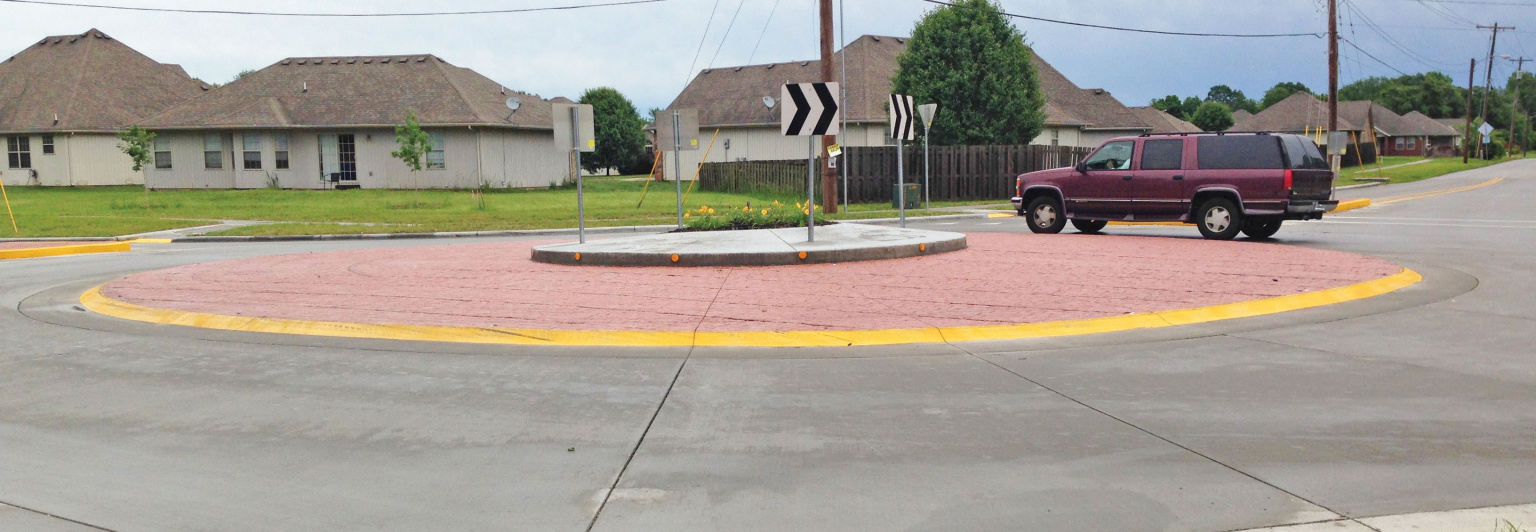While Springfield is known as the “diverging diamond intersection capital of the U.S.,” it’s also becoming home to a dizzying number of roundabout intersections – five, in fact: Airport Boulevard and Division Street, Oak Grove Avenue and Catalpa Street, Maryland Avenue and Walnut Lawn Street, Central Street and Sherman Avenue, and Riverbluff Boulevard and Southwood Street.
Springfield’s first roundabout opened in 2000 at Central and Sherman near Ozarks Technical Community College. The most recent opened at Oak Grove and Catalpa in December 2015 after multiple angle crashes at the former two-way stop. Without traffic signals to maintain, roundabout intersections are also cost-effective. The one at Oak Grove and Catalpa opened at a cost of about $350,000, funded by the 1/8-Cent Transportation Sales Tax, along with funding from the Streets division and Stormwater budgets.
“There were 17 crashes at this intersection in 2013 and 2014, including one fatality and one disabling injury,” said Public Works Assistant Director Martin Gugel. “Oak Grove is used by about 8,000 vehicles per day and functions as an arterial street, even though it’s in a residential area. The speed limit in the area is 30 mph, yet traffic moves much faster through the intersection.”
Roundabouts take some getting used to, Gugel said.
“Once they open, we rarely receive complaints. Drivers see the benefits that roundabouts can provide,” he said. “They are a good intermediate design solution for an intersection with traffic that’s a little too much for an all-way stop to handle, but not quite enough traffic to be signalized.”
Roundabouts simplify intersections, giving the driver a smoother transition to entrances and exits. The one-lane roundabout requires drivers to yield to one-way traffic before entering, then round the loop to the appropriate exit.
According to the Federal Highway Administration, roundabouts reduce traffic fatalities at intersections by 90 percent. In addition, there is a 76 percent reduction in injuries and a 35 percent drop in accidents.
Flashing yellow arrows
Springfield currently has 22 intersections with flashing yellow arrows. Seven of those are operated by MoDOT while the City operates 15.
“We have another one under construction now with one more planned for later this year. MoDOT just let a contract to install 22 more locations along Glenstone, Chestnut, and Kansas Expressway over the next couple years,” said Traffic Engineer Tom Dancey.
Traffic engineers consider flashing yellow left-turn arrows safer because they provide a more direct message to drivers to yield to oncoming traffic than solid green circular signals. Flashing yellow arrows decrease traffic delays and are especially effective at intersections with high volumes of traffic.
These types of yield signals are becoming more common in Springfield after a change in federal traffic regulations making the flashing yellow arrow an optional improvement at certain intersections. The Missouri Department of Transportation (MoDOT) installed the first yellow left-turn arrow in Springfield at Kearney Street and Broadway Avenue in 2015. The signal at Campbell and Primrose will be the first installed by Springfield Public Works. Additional flashing yellow arrows are planned for installation at intersections across the city in the near future.
How they work
A green left-turn arrow remains in place to allow drivers to make protected left turns from the eastbound-to-northbound direction. When the yellow left-turn arrow begins flashing, drivers must yield to oncoming vehicles and pedestrians. When the yellow arrow stops flashing, drivers should prepare to stop. A solid red arrow means “stop.”
Signs marked “Left Turn Yield on Flashing Arrow” will be displayed next to the left-turn signal to clearly explain its meaning.


